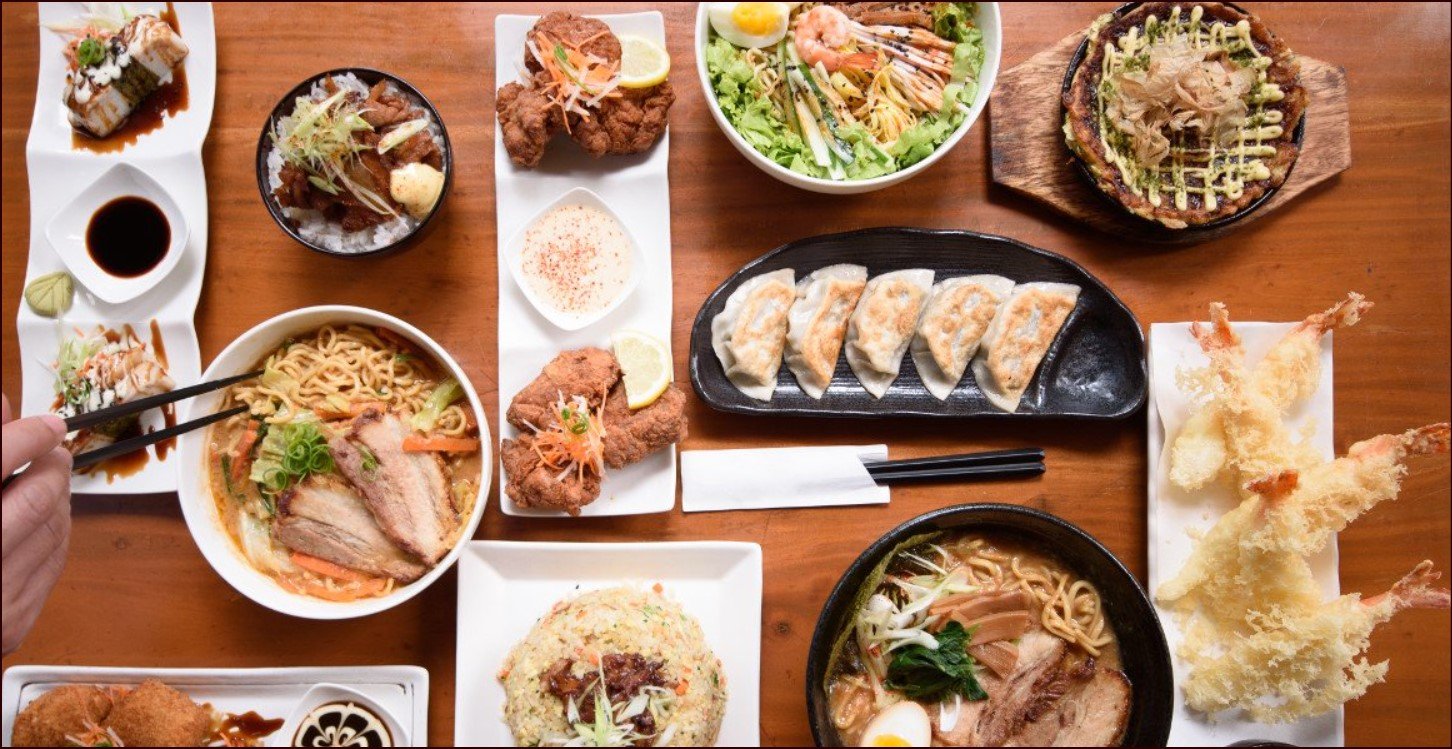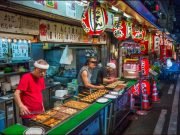Restaurant In Japan: There are many distinct sorts of restaurants. The following are some of the most common restaurant kinds, along with their usual price ranges (per person)
Restaurant In Japan with a Focus

Specialized Japanese Restaurants

1. Sushi-ya in sushi 1,000 to 20,000 yen
Sushi-ya restaurants are sushi-only establishments. Customers can sit at a regular table or at a counter (sushi bar) behind which the sushi chef is working at most sushi-ya.
2. Kaitenzushi 700 to 2,000 yen
Kaitenzushi is a less expensive sushi restaurant where the sushi is served on a conveyor belt to the guests. Customers can pick and choose the foods they want as they travel by or request dishes that aren’t on the conveyor belt.
Sushi is either priced per plate or by a fixed fee, with different coloured plates correlating to different pricing tiers (usually 100-500 yen per plate). Finally, the plates are counted to ascertain the overall amount.
3. Udon-ya and Soba-ya 500 to 1,500 yen
Soba-ya specialises in soba noodle meals, whereas Udon-ya specialises in udon, but both soba and udon are frequently found in either type of restaurant. The majority of noodle dishes are served hot or cold with a dipping sauce on the side. The noodles can be ordered with a variety of toppings (tempura, vegetables, and so on), and the menu changes seasonally.
4. Ramen-ya ramen restaurant 500 to 1,500 yen
Ramen-ya specialises in ramen, a Chinese-style noodle soup with a variety of toppings. Every ramen-ya has created its unique soup, which is the most important component of a restaurant’s success. Other Chinese-inspired meals, like gyoza and fried rice, are frequently offered at ramen-ya.
5. kare-ya 500 to 1,500 yen
Restaurants that specialise in Japanese-style curry rice meals are known as kare-ya. Inside or near large train stations, there is normally at least one kare-ya and one ramen-ya.
6. Gyudon-ya 300 to 1,000 yen
Gyudon-ya is a gyudon restaurant (beef domburi). Gyudon-ya is an affordable, fast food eaterie that can be found all across the country.
7. Yakitori-ya 800 to 2,000 yen
Yakitori-ya specialises in yakitori, which are grilled chicken skewers cooked to order over a charcoal fire. They’re particularly popular among salarymen after work, and, along with ramen-ya, they’re a frequent late-night snack after a night of drinking.
9. Okonomiyaki-ya 700 to 1,500 yen
Okonomiyaki-ya specialises in okonomiyaki, as well as monjayaki on occasion. Customers create their okonomiyaki on a hot plate integrated into the table at some establishments.
9. Tonkatsu-ya Tonk 1,000 to 2,000 yen
Tonkatsu-ya serves deep-fried breaded pork cutlets known as tonkatsu.
10. Tempura-ya Temp 700 to 3,000 yen
Tempura-ya is known for its tempura dishes, including tendon (tempura domburi) and various tempura.
11. Unagi-ya 1,500 to 5,000 yen
Unagi-ya specialises in unagi (freshwater eel) foods such unajuu, which is grilled eel served in a box over rice, and unadon, which is grilled eel served over rice (unagi donburi).
12. Shabu-ya and Sukiyaki-ya 3,000 to 10,000 yen
Sukiyaki-ya emphasis on sukiyaki, while Shabu Shabu-ya specialise in shabu-shabu. These restaurants are frequently located in large, Western-style hotels and are usually rather pricey.
13. Teppanyaki-ya 5,000 to 20,000 yen
The chef prepares meat, seafood, and vegetables on a big iron griddle (teppan) in front of the diners who sit around the griddle in teppanyaki restaurants. Teppanyaki restaurants are typically found in more upscale hotels and are usually quite pricey. They’re well-known for serving quality Japanese beef (wagyu), such as Kobe beef.
Restaurants in general
Some restaurant categories that serve a wider variety of food than specialised restaurants include:
1. Izakaya 1,000 to 5,000 yen
Like pubs, izakaya serves a range of small plates like Japanese robata (grilled food), yakitori, salads, and other finger foods. They are one of Japan’s most popular restaurant kinds, with many of them located near train stations and commercial districts. Izakaya dining is casual, with food shared throughout the table rather than consumed separately.
2. Restaurant for Families 500 to 2,000 yen
Gusto, Royal Host, Saizeria, and Joyful are examples of family restaurants (families), which are casual dining restaurants that often belong to a countrywide chain and provide a mix of Western, Chinese, and Japanese dishes. Family restaurants are more ordinary in rural areas than they are in metropolitan cities.
3. Shokudo 500 to 1,500 yen
Shokudo is informal restaurants that serve Japanese-style food such as soba, udon, donburi, and curry. They are similar to family restaurants in that they are tiny, individually owned, and serve predominantly Japanese-style food. Shokudo is usually seen near tourist attractions.
4. Teishoku-ya 500 to 2,000 yen
Teishoku-ya is a restaurant with pre-determined meals (teishoku). Teishoku is often served with the main course of meat or fish, a bowl of cooked rice, pickles, and miso soup. Teishoku-ya is particularly common in commercial districts and are particularly popular during lunchtime.
5. Coffee Shops and Kissaten 500 to 2,000 yen
Kissaten are coffee cafes that also provide pastries, sandwiches, and salads. Some of them also provide hot food, such as pasta. Museums, shopping malls, and department stores are all common places to find them. There are various chain coffee businesses, such as Starbucks.
6. Ryotei and Kaiseki Ryori 3,000 to 20,000 yen
Kaiseki ryori is sometimes referred to as “Japanese haute cuisine.” Seasonality, simplicity, and elegance are all emphasised in this exquisite multi-course culinary method. It is served at kaiseki ryori restaurants as well as ryotei, which are pricey and exclusive Japanese restaurants. Kaiseki ryori is served in many of the top ryokan.
7. Yatai (Yatai) 300 to 2,000 yen
Yatai are portable food kiosks that may or may not feature seating inside a tent. Their numbers have been steadily diminishing over time. Fukuoka is especially well-known for its yatai. Fried chicken (karaage), okonomiyaki, takoyaki, yakisoba, oden, and ramen are also popular foods.
Cuisine from another country
In Japan, many restaurants specialise in foreign cuisines such as Korean, Chinese, and Italian cuisine. Fast food in the American manner is also very popular.
1. Yakiniku-ya 1,500 to 7,500 yen
Yakiniku-ya specialises in Korean barbecue, where little pieces of meat are barbecued at the table on a grill. Bibimba, reimen, and chige are all popular Korean foods that may be found at a yakiniku-ya.
2. Chinese eateries 700 to 5,000 yen
In Japan, there are numerous Chinese restaurants. Many of them specialise on Japaneseized Chinese cuisine, while others specialise in true Chinese cuisine.
3. yoshoku-ya (800 to 3,000 yen
Yoshoku-ya are restaurants that specialise in yoshoku ryori, or Western foods that were imported to Japan during the Meiji Period (1868-1912) and thereafter Japaneseized. Omuraisu, hambagu, and hayashiraisu are all common yoshoku-ya foods.
4. Restaurants serving Italian cuisine 1,000 to 3,000 yen
Pasta restaurants may be found all around Japan, and Italian cuisine is particularly popular. Many restaurants offer Japanese-inspired pasta dishes (such as tarako spaghetti) alongside more traditional pasta meals.
5. Restaurants in France 1,500 to 20,000 yen
In Japan, French restaurants are very popular. They’re usually stylish and pricey, and they’re frequently seen in good hotels.
6. Fast Food Hamburger 300 to 1,500 yen
In Japan, there are numerous hamburger fast food establishments. They include prominent American fast-food chains like McDonald’s and Burger King, as well as Japanese fast-food chains like Mos Burger and Lotteria.
7. Restaurants serving Indian cuisine 700 to 2,000 yen
Indian restaurants can be found all over Japan, particularly around major train stations and shopping malls. They serve Indian curry rather than Japanese curry, and most of their menus provide vegetarian options.
8. Ethnic Foods 700 to 2,000 yen
“Ethnic cuisine” in Japan refers to food from Southeast Asia, such as Thai, Indonesian, and Vietnamese cuisine. These restaurants are not as prevalent as the others, however, they can be found on the restaurant floors of larger department stores.
Also Read:








![Buying the Dip: The Meaning And Its Importance [Markets Strategy] Buying the Dip](https://fox24x7.com/wp-content/uploads/2021/11/Buying-the-Dip--180x135.jpg)

























